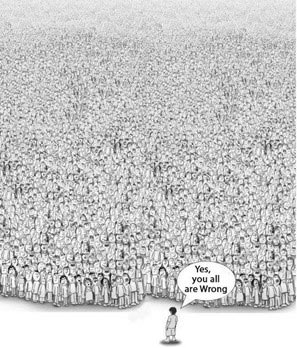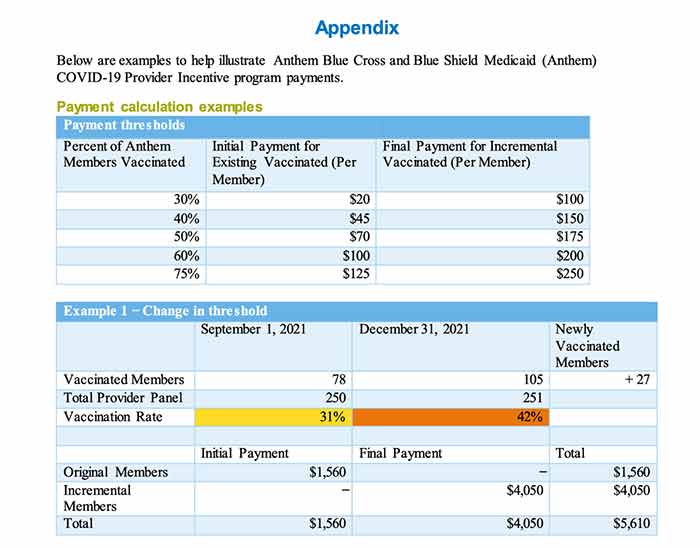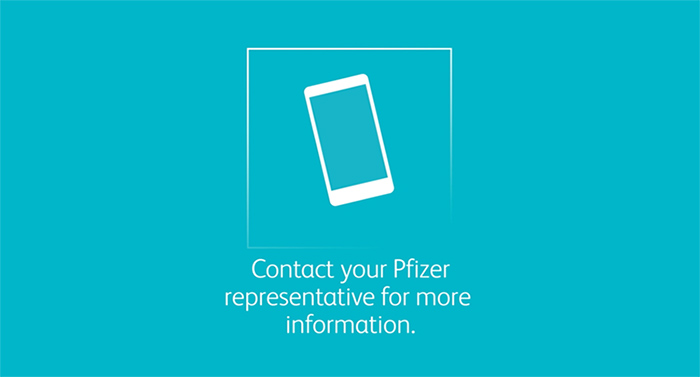This story is about the crossroads and the long-term significance of our everyday choices. It is also about the practical strategy of making choices wisely and without fear. Oh, and Anthem. It is also about Anthem bribing physicians to put shots in arms.
Why do our everyday choices matter? Because the road to fully-blown hell is usually paved with a gradual erosion of standards and with small — but gradually increasing — compromises with the bad guys. Psychological pressure against wise choices is a deliberate step. It’s a metaphorical spell.
Under the boot of being treated unfairly, individual people often shrink and feel isolated, invisible, and insignificant — and as a result, each person may presume that their choices probably don’t matter, and that some other, bigger, more important and visible, people will make the choices saving the world — and then the world just keeps dancing to the drum of the bad guys and drowning in tears of the shrunk good guys.
That particular dynamic of self-betrayal has occurred so many times in history that it’s not even cute. And in the end, after a very long journey through rough terrain, things usually turn around — but that only happens when people start acting wise! And sometimes, choosing the right thing feels just very — but it’s okay to feel this way temporarily and still chose to do the right thing:

Timing Matters
The tactical challenge of “waking people up” is that it usually takes a while for the standards to fully erode, and in the meanwhile, people often choose to ignore the “sea change” until the consequences of the eroded standards start stinking rancidly — and directly into people’s noses.
For example, the lockdowns of 2020 and the incredible attack on citizen dignity would have been impossible without a preceding cascade of psychological “updates” that, little by little, ate into the public perception of how protected one’s personal space should be, and how much intrusion by authority figures would be too much.
Remember the arc? “See something, say something,” the ritual of taking off the shoes at the airport like obedient little slaves, the normalization of paternalistic barking by the political talking heads — and this is how little by little, bite by bite, the psychological stage was set for what we experienced in 2020.
My personal observation of the past three years is that “living in interesting times” dystopia is a sobering and humbling educational experience because it made me realize that this is how history works, and this is exactly how it worked in the past, too.
And human choices matter. When individual human beings make choices to defend each other’s freedom and dignity no matter what, we are invincible, and we win fast. When human beings fall onto bad habits and ego tantrums, victory is delayed.
And today, as the aspiring masters are bullying way day and night to downgrade our standards for a dignified life, some pay attention to this egregious erosion of standards, some sing and scream and shout from the rooftops and fight the indignity with tooth and claw — but many just go about their day. And the trick is to not be discouraged, to stick our necks out for the ones who need our love — and to not stick them out for the yoke even if our hearts feel temporarily alone.
Vampires and the Waterfall: A Fairy Tale
Let’s do a thought experiment. Imagine a beautiful, peaceful, clear waterfall. The waterfall is there as it has been since time immemorial, flowing freely, not owned by anyone, available to all.
And then one day, comes a family of fairy tale vampires, a congress of proverbial hungry spirits who are trying to fill the void with power over others and object hoarding. They see the waterfall and, since they are annoyed by unmonetized beauty, they block the waterfall off. Having blocked it off and built a dam, they open an irrigation facility, a water bottling facility, and a water-based products store. And maybe even hire some of the locals to work at their enterprise, providing valuable ‘jobs.’
Now, I don’t know how and why the people in this hypothetical tale just let the robbery fly — but maybe they were just like us, and they got bamboozled and taken by surprise. Perhaps every single person assumed that if this were important and lasting enough, someone would surely do something about it — and then nobody did, and then the abuse was too big, and it was too late. Sound like something we see every day in real life, no?
And then the children, born into this “new world order” without a waterfall, simply adapt to the new rules, assuming that from time immemorial, people had to work hard to earn the money to purchase water for their needs.
As time goes by, a new system of social values develops around the new circumstance of water scarcity, and new language is born to reflect the change. Those who can still feel the blood memory of insult and who are somehow unmotivated to work “for the man” get labeled as lazybones, while those who were resilient enough to comply without losing their faces and minds, get praised and incentivized.
The hungry spirit family even opens a free school for local kids, teaching them skills required for work at their enterprise — and parents start telling their own children that if they study at the “public” school hard enough, they may become successful like the shiny-bellied Mr. Manager at the water products store!
And the kids who learn everything about their world from their adults just buy into it. And the memory of a world before the grand theft of the waterfall becomes paler and paler each day, until it becomes a myth about something that couldn’t exist.
Incentives
Let’s take a break from the fairy tale and talk about “incentives” using a real-life example from a real-life analogy of the “world without a waterfall.” As we talk about it, the point to keep in mind is how we got there and what happened to our professional and ethical standards along the way.
Here is a description of an Anthem COVID-19 Vaccine Provider Incentive Program, straight out of the horse’s mouth:


And here’s Anthem’s “salesman’s manual” (my term, their source):
Research shows that a strong vaccination recommendation from a provider is the greatest motivator for people of all ages to vaccinate themselves and their family members against serious infectious diseases. Use the information in this page to help protect yourself and our members from falling victim to vaccine-preventable diseases.
Keeping all patients healthy and safe requires the support and collaboration of the entire healthcare industry. Let’s Vaccinate offers providers tools and strategies to aid in vaccinating people of all ages. Let’s Vaccinate is a collaboration of Anthem, Inc., Pfizer Inc., and Vaccinate Your Family [emphasis mine].
Lest we forget, here is the most important bit:

“Let’s Vaccinate”
The “Let’s Vaccinate” program (in collaboration with Pfizer, yes) teaches medical providers how to authoritatively, convincingly — and incessantly — nudge the patients about their vaccine intake, as well as how to improve their medical practice’s “workflow” to make vaccine harassment a standard part of the routine. Every bullet point is a scream of its own but here is a telling example of “proactive outreach“:
Let’s Vaccinate created this vaccine reminder postcard for healthcare providers to send to patients. Healthcare providers can personalize the postcard by adding their practice logo, name, and phone number. Print out the 4″ x 6″ postcard on heavy paper. Please consider following the U.S. Department of Health and Human Services (HHS) guidance for accommodating patient choice with respect to postcard mailings.
And here are some examples of Anthem-branded hypnosis, sorry, I meant to say, their “suggested responses” to “vaccine hesitancy,” using the example of the flu shot:

And, for context, here is blast from the past (a 1996 bit from a page on the CDC website, last updated in 1998):
This statement by the Advisory Committee on Immunization Practices (ACIP) presents programmatic strategies to increase vaccination rates. This is the first statement to recommend the use of routine assessment and feedback of provider-based vaccination coverage information.
Routine assessment and feedback of vaccination rates obtained at the provider site is one of the most effective strategies for achieving high, sustainable vaccine coverage.
For example, in 1986 [emphasis mine, and remember what else happened in 1986?], the Immunization Program of the Division of Public Health, Georgia Department of Human Resources, initiated a program to assess annually the vaccination records of children enrolled in public health clinics to determine progress toward achieving the national goal of 90% series-complete coverage by age 2 years.
During 1986-1994, series-complete vaccination rates at age 2 years among children in public health clinics increased from less than 40% to approximately 80% — an increase attributed to assessment and feedback, which motivated providers to develop and implement targeted interventions (1,2;CDC, unpublished data, 1996).
Assessment and feedback also has resulted in substantial increases in vaccination rates in public health clinics in Colorado, Illinois, Iowa, Kansas, and South Carolina (3-5;CDC, unpublished data, 1996). Assessments in private and managed-care provider settings in Arizona, Massachusetts, New York, and Washington suggest that this strategy also can improve rates in these settings.
We could spend a very long time going down this particular rabbit hole of policy shaping, corporate influence, insufficient curiosity and wishful thinking on the part of the doctors, and straight out corruption. There are numerous documents and marketing brochures that give away the trail of breadcrumbs having led us to where we are right now. But psychologically — psychologically — how did we get there?
The Conundrum
Let’s go back to the waterfall fairy tale. How did the people who were living at the time of the grand waterfall theft get hoodwinked? Was there a bloodshed? Would there be a bloodshed if they all just said no?
Was there perhaps an act of metaphorical hypnosis and dark spiritual activity on the part of the ones with troubled hearts? Was there a campaign of divide and conquer that pit the locals against each other at the most critical time?
Were there many individual choices made in favor of assuming one’s helplessness against the ‘trends’? Were the people tricked into feeling guilty, defective and backward for loving the waterfall as it was?
Were the children propagandized against the adults? Were the parents lied to about the dangers of the waterfall to kids? Were the people terrorized with imaginary things? How did it go? And once the “new world order” was established and internalized by most, what can they do to break free?
Our Choices Matter
The point I am making is the philosophical one. How many individual choices were made to shape the arc of history and the current state of the world? Probably, billions of choices, good and bad. And each time, a concrete individual at a personal crossroads was deciding which way to go. Not invisible. Not unimportant — but a part of the whole.
That awareness, in my opinion, is what can help us keep our focus on the victory of dignity and to maintain our spine. It’s the understanding that we are here to do our job. It may feel at times like we are invisible — but we are not. And in both the spiritual the practical ways, every choice has weight. We are not alone, and the universe is breathing into our wings when we do what’s right — even if doesn’t immediately feel this way.
My important personal discovery of the past few years is that following my heart is sweet. Freedom is a sweet thing. I am not a slave — and neither are you.
About the Author
To find more of Tessa Lena’s work, be sure to check out her bio, Tessa Fights Robots.
